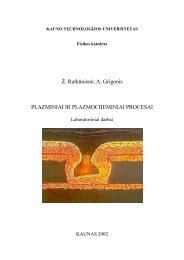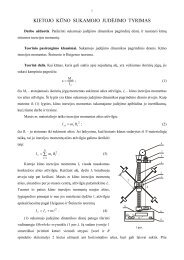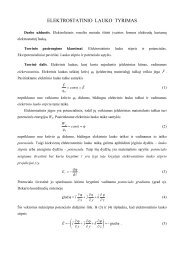PROCEEDINGS OF THE 7 INTERNATIONAL ... - Fizika
PROCEEDINGS OF THE 7 INTERNATIONAL ... - Fizika
PROCEEDINGS OF THE 7 INTERNATIONAL ... - Fizika
Create successful ePaper yourself
Turn your PDF publications into a flip-book with our unique Google optimized e-Paper software.
MEDICAL PHYSICS IN <strong>THE</strong> BALTIC STATES 7 (2009)<br />
Proceedings of International Conference “Medical Physics 2009”<br />
8 - 10 October 2009, Kaunas, Lithuania<br />
INVESTIGATION <strong>OF</strong> POROUS SILICON IRRADIATED WITH X-RAY<br />
PHOTONS<br />
Skirmantė MOCKEVIČIENĖ*, Igoris PROSYČEVAS**, Vaida KAČIULYTĖ*, Rita PIKAITĖ*, Diana ADLIENĖ*<br />
*Kaunas University of Technology,<br />
**Institute of Physical Electronics, Kaunas University of Technology<br />
Abstract: Porous silicon structures produced using vapor phase chemical etching method and exposed to 15 MeV X-ray<br />
photons have been investigated. It was found that irradiation introduces some changes of the chemical bonding structure<br />
related to the hydrogen release during exposure and is responsible for the changes of the pore growth mechanism, which<br />
could be used formatting porous structures for radiation detectors.<br />
Keywords: porous silicon, X-ray irradiation, chemical bonding structure, pores<br />
1. Introduction<br />
Porous silicon structures are characterized through<br />
broad application spectrum, including technology and<br />
medicine due to their specific structure-related<br />
properties, simplicity and cheapness of their production<br />
[1]. One of the possible applications of porous silicon is<br />
flat panel radiation detectors. Porous silicon detectors<br />
with a large active interaction area are well known as a<br />
broad band and high sensitivity detectors.<br />
Properties of porous structures are dependent on the<br />
fabrication method and technological parameters.<br />
Modification of structures is possible via interaction of<br />
energetic particles with a target too. However to our<br />
knowledge, there is a lack of information concerning<br />
modification of porous Si due to its interaction with<br />
accelerated X-ray photons (medical energy range, 10-15<br />
MeV).<br />
2. Materials and methods<br />
Method of chemical vapor etching was used for the<br />
obtaining of porous structures. Si (111) samples with a<br />
surface area of 1cm 2 were placed into Teflon cell at a<br />
distance 0f 10 cm from the liquid surface of etching<br />
acids mixture. Mixture of HF and HNO3 acids of<br />
different concentration was used. The samples were<br />
fabricated varying concentrations of acids and etching<br />
time.<br />
Two groups of samples have been investigated:<br />
1.samples, which were produces varying HF and HNO3<br />
concentrations (1:1; 1:2; 1:6) in a mixture, but keeping<br />
the same etching time of 24 hours, and 2. samples,<br />
which were produced using the same concentration of<br />
acids in the mixture (HF:HNO3 - 4:1), but varying the<br />
time of etching (24 hr, 48 hr, 60 hr)<br />
121<br />
Fabricated samples were irradiated with high energy (15<br />
MeV) X-ray photons, which were generated in medical<br />
linear accelerator Clinac 2100C (VARIAN). Dose of<br />
2Gy was delivered to all investigated porous Si targets.<br />
Chemical bonding structure of the samples was<br />
investigated using FTIR spectrometer Nicolet 5700<br />
equipped with 10 Spec modality (10 Degree Specular<br />
Reflectance Accessory).<br />
Optical properties of the samples were estimated using<br />
laser ellipsometer Gaertner 117 (exciting wavelength<br />
632,8 nm) as well as optical interferometer [2]. Porosity<br />
of the samples was evaluated using Bruggeman‘s<br />
formula [3]:<br />
2 2 2<br />
( 1−n PS ) ⋅ ( nSi + 2⋅nPS)<br />
2 2<br />
3⋅nPS ⋅( 1−nSi<br />
)<br />
⎡ ⎤<br />
P = 1−⎢ ⎥⋅100%<br />
⎢⎣ ⎥⎦<br />
Where nSi is Si the refraction index and nPSi is the<br />
refraction index of porous silicon.<br />
Surface morphology was investigated using optical<br />
microscope MMU-3, supported wit digital camera<br />
Canon5.<br />
3. Results and Discussion<br />
Properties of porous silicone structure depend on the<br />
concentration of the etching acids and etching time<br />
(Table1). It was found that an increase of HNO3<br />
concentration in the mixture, when etching time is the<br />
same, leads to the formation of thinner porous layers,<br />
however the number of pores increases (Fig.1: a, b, c). It<br />
is possible to achieve pore growth if the time of etching<br />
increases (Fig.1: d, e, f).








